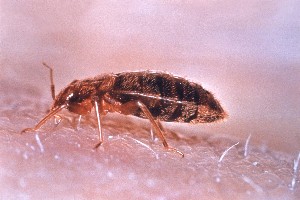If you do have bed bugs, the last thing you want is them getting into your bed. Purchase hypoallergenic covers for your mattress, comforter and pillows to kill any infestation that may be living in them. This is also an excellent preventative measure to do prior to an infestation to prevent bugs from finding a way into your bedding.
Bed bugs are resistant to many/most chemicals, but you may want to consider Diatomaceous earth.
Wikipedia tells us:
Diatomaceous earth, also known as DE, diatomite, diahydro, kieselguhr, kieselgur and Celite) is a naturally occurring, soft, chalk-like sedimentary rock that is easily crumbled into a fine white to off-white powder. This powder has an abrasive feel, similar to pumice powder, and is very light, due to its high porosity. The typical chemical composition of diatomaceous earth is 86% silica, 5% sodium, 3% magnesium and 2% iron.
DE can be distributed using a puffer (and while wearing a respirator mask) to slowly kill bed bugs. The dusting remains effective as long as it stays on your floor, so there isn't a need to reapply. DE is not an instant kill solution -- it wears out their outer shell and dehydrates them to death, which takes a few days. This can be a good solution to preventing a re-infestation, but always check with your pest control provider to ensure its not interfering with their own treatment. And remember, DE should not be inhaled. It can cause silicosis, a respiratory disease brought on by inhaling silica.
Climb up insect interceptors are another good option. They can be purchased or you can try to make your own. The commercial versions work by luring the bug up into a moat that it cannot escape from (similar to the inverted dog bowl/dry ice idea). Place your bed post in the middle and watch bugs fail to get up the post searching for a meal. If you make your own, you can place your bed post in a bowl with either soapy water or oil, either of which will kill bugs by drowning.
Your best option for eradicating bed bugs is heat. They may be resistant to chemicals and sprays, but they are not resistant to being burned alive. Clothes should be washed in the hottest water your washer can provide (at least 120 degrees) and placed in a hot dryer for at least 40 minutes. Since bed bugs love hiding in couches, beds, under carpets and any tiny crevice they can find, a good dry steamer is indispensable. To kill bed bugs and their eggs on contact the steamer should reach at least 200 degrees at its tip. You can test the heat coming from your steamer using an instant read thermometer under an area you may want to steam. The thermometer must reach at least 180 degrees to kill bugs and eggs on contact.
Bedbugger.com has many more suggestions for on steamers and all of the other treatments listed above.
Exercise caution with all of the techniques listed above as some of them can cause bodily harm if administered incorrectly. And look up, you can beat a bed bug infestation, it just takes time and persistence.
